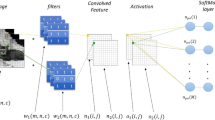Abstract
The most widely used activation functions in current deep feed-forward neural networks are rectified linear units (ReLU), and many alternatives have been successfully applied, as well. However, none of the alternatives have managed to consistently outperform the rest and there is no unified theory connecting properties of the task and network with properties of activation functions for most efficient training. A possible solution is to have the network learn its preferred activation functions. In this work, we introduce Adaptive Blending Units (ABUs), a trainable linear combination of a set of activation functions. Since ABUs learn the shape, as well as the overall scaling of the activation function, we also analyze the effects of adaptive scaling in common activation functions. We experimentally demonstrate advantages of both adaptive scaling and ABUs over common activation functions across a set of systematically varied network specifications. We further show that adaptive scaling works by mitigating covariate shifts during training, and that the observed advantages in performance of ABUs likewise rely largely on the activation function’s ability to adapt over the course of training.
Access this chapter
Tax calculation will be finalised at checkout
Purchases are for personal use only
Similar content being viewed by others
Notes
- 1.
With respect to the constraints, the affine() units in [20] are equivalent to ABU\(_\mathrm{nrm}\), and their convex() units are equivalent to ABU\(_\mathrm{pos}\). Unfortunately, the authors did not provide details with respect to their implementation, so we cannot say whether or not the implementations are equivalent.
References
Agostinelli, F., Hoffman, M., Sadowski, P., Baldi, P.: Learning activation functions to improve deep neural networks. arXiv preprint arXiv:1412.6830 (2014)
Alcaide, E.: E-swish: adjusting activations to different network depths. arXiv preprint arXiv:1801.07145 (2018)
Ba, J.L., Kiros, J.R., Hinton, G.E.: Layer normalization. arXiv preprint arXiv:1607.06450 (2016)
Clevert, D.-A., Unterthiner, T., Hochreiter, S.: Fast and accurate deep network learning by exponential linear units (elus). arXiv preprint arXiv:1511.07289 (2015)
Dushkoff, M., Ptucha, R.: Adaptive activation functions for deep networks. Electron. Imaging 2016(19), 1–5 (2016)
Eisenach, C., Wang, Z., Liu, H.: Nonparametrically learning activation functions in deep neural nets (2016). https://openreview.net/pdf?id=H1wgawqxl, https://scholar.google.de/scholar?hl=en&assdt=0%2C5&q=https%3A%2F%2Fopenreview.net%2Fpdf%3Fid%3DH1wgawqxl&btnG=
Glorot, X., Bordes, A., Bengio, Y.: Deep sparse rectifier neural networks. In: Proceedings of the Fourteenth International Conference on Artificial Intelligence and Statistics, pp. 315–323 (2011)
Godfrey, L.B., Gashler, M.S.: A continuum among logarithmic, linear, and exponential functions, and its potential to improve generalization in neural networks. In: 2015 7th International Joint Conference on Knowledge Discovery, Knowledge Engineering and Knowledge Management (IC3K), vol. 1, pp. 481–486. IEEE (2015)
Goodfellow, I.J., Warde-Farley, D., Mirza, M., Courville, A., Bengio, Y.: Maxout networks. arXiv preprint arXiv:1302.4389 (2013)
Hahnloser, R.H.R., Sarpeshkar, R., Mahowald, M.A., Douglas, R.J., Seung, H.S.: Digital selection and analogue amplification coexist in a cortex-inspired silicon circuit. Nature 405(6789), 947 (2000)
He, K., Zhang, X., Ren, S., Sun, J.: Delving deep into rectifiers: surpassing human-level performance on ImageNet classification. In: Proceedings of the IEEE International Conference on Computer Vision, pp. 1026–1034 (2015)
Ioffe, S., Szegedy, C.: Batch normalization: accelerating deep network training by reducing internal covariate shift. arXiv preprint arXiv:1502.03167 (2015)
Kingma, D.P., Ba, J.: Adam: a method for stochastic optimization. CoRR, abs/1412.6980 (2014). http://arxiv.org/abs/1412.6980
Klambauer, G., Unterthiner, T., Mayr, A., Hochreiter, S.: Self-normalizing neural networks. In: Advances in Neural Information Processing Systems, pp. 972–981 (2017)
Krizhevsky, A.: Learning multiple layers of features from tiny images. Tech Report (2009). http://citeseerx.ist.psu.edu/viewdoc/download?doi=10.1.1.222.9220&rep=rep1&type=pdf, https://scholar.google.de/scholar?hl=en&assdt=0%2C5&q=Learning+multiple+layers+of+features+from+tiny+images&btnG=
Krizhevsky, A., Sutskever, I., Hinton, G.E.: ImageNet classification with deep convolutional neural networks. In: Advances in Neural Information Processing Systems, pp. 1097–1105 (2012)
Leugering, J., Pipa, G.: A unifying framework of synaptic and intrinsic plasticity in neural populations. Neural Comput. 30(4), 945–986 (2018). https://scholar.google.de/scholar?hl=en&assdt=0%2C5&q=A+unifying+framework+of+synaptic+and+intrinsic+plasticity+in+neural+populations.+Neural+Comput.&btnG=#d=gscit&u=%2Fscholar%3Fq%3Dinfo%3AXsUGb1r4qYAJ%3Ascholar.google.com%2F%26output%3Dcite%26scirp%3D0%26hl%3Den
Li, X., Chen, S., Hu, X., Yang, J.: Understanding the disharmony between dropout and batch normalization by variance shift. arXiv preprint arXiv:1801.05134 (2018)
Maas, A.L., Hannun, A.Y., Ng, A.Y.: Rectifier nonlinearities improve neural network acoustic models. In: Proceedings of the ICML, vol. 30, p. 3 (2013)
Manessi, F., Rozza, A.: Learning combinations of activation functions. arXiv preprint arXiv:1801.09403 (2018)
Nair, V., Hinton, G.E.: Rectified linear units improve restricted Boltzmann machines. In: Proceedings of the 27th International Conference on Machine Learning (ICML 2010), pp. 807–814 (2010)
Ramachandran, P., Zoph, B., Le, Q.V.: Searching for activation functions. CoRR, abs/1710.05941 (2017). http://arxiv.org/abs/1710.05941
Srivastava, N., Hinton, G., Krizhevsky, A., Sutskever, I., Salakhutdinov, R.: Dropout: a simple way to prevent neural networks from overfitting. J. Mach. Learn. Res. 15, 1929–1958 (2014). http://jmlr.org/papers/v15/srivastava14a.html
Turrigiano, G.G., Nelson, S.B.: Homeostatic plasticity in the developing nervous system. Nat. Rev. Neurosci. 5(2), 97 (2004)
Xu, B., Wang, N., Chen, T., Li, M.: Empirical evaluation of rectified activations in convolutional network. arXiv preprint arXiv:1505.00853 (2015)
Author information
Authors and Affiliations
Corresponding author
Editor information
Editors and Affiliations
Rights and permissions
Copyright information
© 2020 Springer Nature Switzerland AG
About this paper
Cite this paper
Sütfeld, L.R., Brieger, F., Finger, H., Füllhase, S., Pipa, G. (2020). Adaptive Blending Units: Trainable Activation Functions for Deep Neural Networks. In: Arai, K., Kapoor, S., Bhatia, R. (eds) Intelligent Computing. SAI 2020. Advances in Intelligent Systems and Computing, vol 1230. Springer, Cham. https://doi.org/10.1007/978-3-030-52243-8_4
Download citation
DOI: https://doi.org/10.1007/978-3-030-52243-8_4
Published:
Publisher Name: Springer, Cham
Print ISBN: 978-3-030-52242-1
Online ISBN: 978-3-030-52243-8
eBook Packages: Intelligent Technologies and RoboticsIntelligent Technologies and Robotics (R0)




